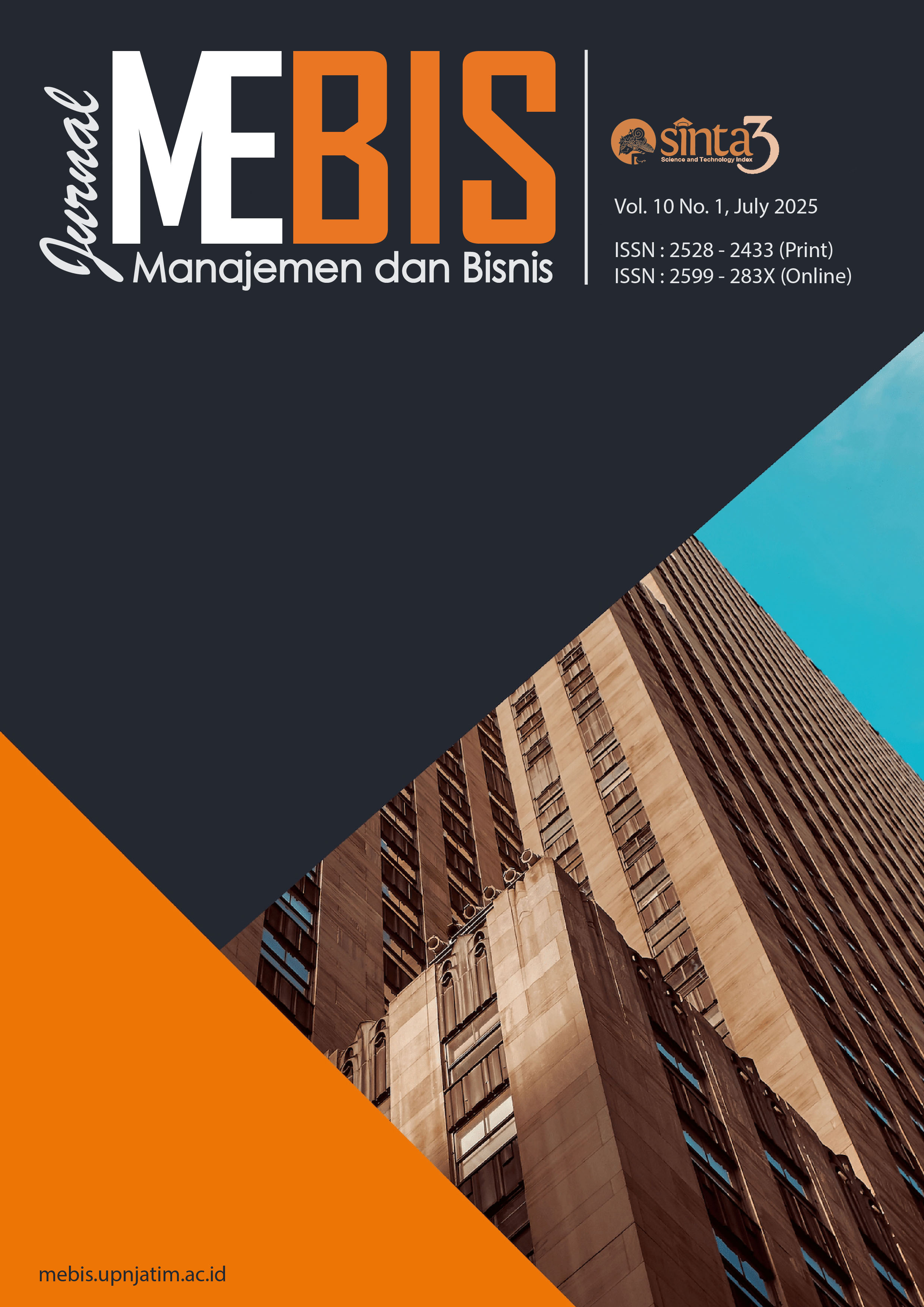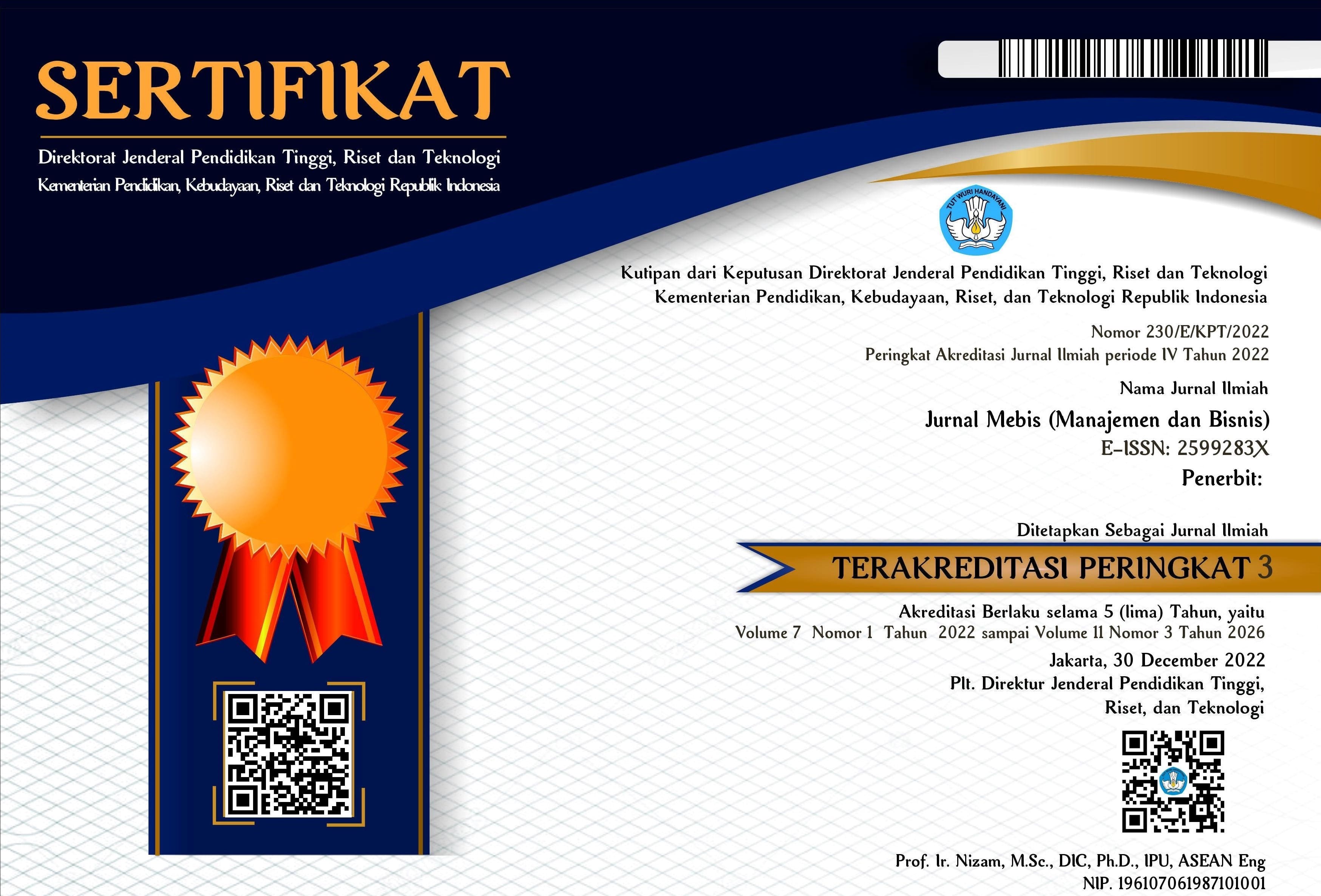Impact of Climate Change on Sustainable Competitive Advantage of Traditional Salt in Central Java
DOI:
https://doi.org/10.33005/mebis.v10i1.684Keywords:
Traditional salt, Climate change, Productivity, Quality, Sustainable competitive advantageAbstract
Indonesia's salt production has great potential, but is still hampered by fluctuations in quality and productivity influenced by weather factors. Dependence on the weather causes instability in salt production results, which impacts achieving salt self-sufficiency. Therefore, this study aims to analyze the influence of climate factors on the productivity and quality of traditional salt in Central Java Province, including temperature, humidity, rainfall, and wind speed. This study uses a quantitative approach, with data collected from 8 salt-producing districts/cities in Central Java with purposive sampling. Climate data was obtained from BMKG, while productivity and quality data were obtained from the Central Java DKP. The analysis technique used panel data regression with the Least Squares (OLS) approach and the Chow, Hausman, and Lagrange Multiplier tests to select the best model. The results showed that rainfall significantly negatively affected traditional salt productivity, while temperature, humidity, and wind speed did not show a significant effect. Overall, climate conditions were shown to affect salt productivity positively. Temperature and humidity have a significant positive effect on salt quality, wind speed has a significant negative effect, and rainfall has no significant effect on salt quality. Overall, climate conditions have a positive effect on salt quality. Rainfall and temperature management are essential to increase salt productivity and quality, while climate factor management will produce optimal results. The development of modern salt production technology that reduces dependence on extreme weather and better management of natural resources and technology can support the achievement of more stable and sustainable salt self-sufficiency.
Downloads
References
Achmad, F. (2023). Peran inovasi dalam meningkatkan kinerja industri pariwisata berkelanjutan di Indonesia. Jurnal Multidisiplin West Science, 2(03), 150–157. https://doi.org/10.58812/jmws.v2i03.244
Adiraga, Y., & Setiawan, A. H. (2014). Analisis dampak perubahan curah hujan, luas tambak garam, dan jumlah petani garam terhadap produksi usaha garam rakyat di Kecamatan Juwana Kabupaten Pati Periode 2003-2012. Diponegoro Journal of Economics, 3(1), 1–13. https://doi.org/10.14710/djoe.5314
Ainurrohmah, S., & Sudarti, S. (2022). Analisis perubahan iklim dan global warming yang terjadi sebagai fase kritis. Jurnal Phi: Jurnal Pendidikan Fisika Dan Fisika Terapan, 8(1), 1–10. https://doi.org/10.22373/p-jpft.v8i1.13359
Akinaga, T., Generalis, S. C., Paton, C., Igobo, O. N., & Davies, P. A. (2018). Brine utilisation for cooling and salt production in wind-driven seawater greenhouses: design and modelling. Desalination, 426, 135–154. https://doi.org/10.1016/j.desal.2017.10.025
Alamsyah, I. F., Esra, R., Awalia, S., & Nohe, D. A. (2022). Analisis regresi data panel untuk mengetahui faktor yang mempengaruhi jumlah penduduk miskin di Kalimantan Timur. Prosiding Seminar Nasional Matematika, Statistika, Dan Aplikasinya, 254–266. https://jurnal.fmipa.unmul.ac.id/index.php/SNMSA/article/view/861
Aldi, D., Nurhayati, N., & Putri, E. I. K. (2021). Resiliensi dan adaptasi petani garam akibat perubahan iklim di Desa Donggobolo, Kecamatan Woha, Kabupaten Bima. Jurnal Pengelolaan Lingkungan Berkelanjutan (Journal of Environmental Sustainability Management), 5(1), 604–618. https://doi.org/10.36813/jplb.5.1.604-618
Alshahrani, M. A., Yaqub, M. Z., & Alabdali, M. A. (2024). Examining the role of intellectual capital in maturing sustainable competitive advantage through enkindling innovations in smes: the moderating role of entrepreneurship-orientation. Journal of Intellectual Capital, 25(2–3), 328–359. https://doi.org/10.1108/JIC-05-2023-0111
Amalyos. (2020). Peran Kemenko Marves dalam Pengembangan Diversifikasi Produk Turunan Garam di Masa Depan. Kkp.Go.Id. https://kkp.go.id/an-component/media/upload-gambar-pendukung/DitJaskel/publikasi-materi-2/diversifikasi-garam/A5 diversifikasi garam artemia dan bittern.pdf
Amin, A. A., Salamah, L. N., Zamzami, I. M. Al, Susanti, Y. A. D., Yanuar, A. T., & Kurniawan, A. (2024). Aplikasi tandon-filter untuk meningkatkan kualitas dan kuantitas garam dalam teknologi greenhouse salt tunnel di pantai selatan dan utara Jawa Timur. Rekayasa: Journal of Science and Technology, 17(1), 143–151. https://doi.org/10.21107/rekayasa.v17i1.24877
Aminullah, M. M. (2023). Pengaruh Variasi Temperatur Terhadap Kualitas Garam Pada Mesin Purifikasi Garam di Miniplant Garam Universitas Trunojoyo Madura [Universitas Trunojoyo Madura]. https://library.trunojoyo.ac.id/elib/detil.php?id=26442
Amir, N., Efendy, M., Yoo, Y. J., & Gozan, M. (2021). Improved salt quality and reduced energy consumption via hot air drying. International Journal of Technology, 12(3), 592–601. https://doi.org/10.14716/ijtech.v12i3.4853
Arwiyah, Zainuri, M., & Efendy, M. (2015). Studi kandungan nacl di dalam air baku dan garam yang dihasilkan serta produktivitas lahan garam menggunakan media meja garam yang berbeda. Jurnal Kelautan, 8(1), 1–9. https://doi.org/10.21107/jk.v8i1.804
Ashilah, A. A., Wirasatriya, A., & Handoyo, G. (2022). Analisis variabel fisika perairan terhadap kuantitas produksi garam di Kabupaten Rembang. Indonesian Journal of Oceanography, 04(02), 68–76. https://ejournal2.undip.ac.id/index.php/ijoce/article/download/14006/7245
Asnawi, A., & Ambari, M. (2025). Mengejar Swasembada Garam di Tengah Krisis Iklim. Https://Www.Mongabay.Co.Id/. https://www.mongabay.co.id/2025/04/26/mengejar-swasembada-garam-di-tengah-krisis-iklim/
Badan Pusat Statistik. (2024). Impor Garam menurut Negara Asal Utama, 2017-2023. Badan Pusat Statistik. https://www.bps.go.id/id/statistics-table/1/MjAxMyMx/impor-garam-menurut-negara-asal-utama--2017-2022.html
Badi’ah, R., Handayani, W., & Swasti, I. K. (2023). Improving the quality of people’s salt using the blue economy concept in East Java Province, Indonesia. Journal of Business and Management Studies, 5(1), 110–126. https://doi.org/10.32996/jbms.2023.5.1.12
Banowati, E., & Firmanzah, F. (2023). Cuaca dan kegiatan pertanian garam di kecamatan Kaliori - Rembang. In Bookchapter Alam Universitas Negeri Semarang (Vol. 1, Issue 2, pp. 68–93). https://doi.org/10.15294/ka.v1i2.144
Bramawanto, R., Ratnawati, H. I., & Supriyadi, S. (2019). Variabilitas hidrologis dan dinamika produksi garam pada beragam kondisi enso di Kabupaten Pati dan Rembang. Jurnal Segara, 15(1), 45–54. https://doi.org/10.15578/segara.v15i1.7593
BRIN. (2023). Indonesia Menuju Swasembada Garam 2024. Https://Www.Brin.Go.Id/. https://www.brin.go.id/news/116757/indonesia-menuju-swasembada-garam-2024?
Catherin. (2024). 5 Provinsi dengan Produksi Garam Terbanyak di Indonesia 2023. GoodStats. https://data.goodstats.id/statistic/5-provinsi-dengan-produksi-garam-terbanyak-di-indonesia-2023-WyCzQ
CNBC Indonesia. (2023). Berkah El Nino 2023, Produksi PT Garam Tembus 315 Ribu Ton! CNBC Indonesia. https://www.cnbcindonesia.com/company-update/20231214092805-49-497212/berkah-el-nino-2023-produksi-pt-garam-tembus-315-ribu-ton?utm_source=chatgpt.com
Desarnaud, J., & Shahidzadeh-Bonn, N. (2011). Salt crystal purification by deliquescence/crystallization cycling. EPL, 95(4). https://doi.org/10.1209/0295-5075/95/48002
Faisol, Ukhrowi, P., M., M. F. F., Yudistira, I., & Kuzairi. (2022). Comparison of salinity and seawater temperaature predictions using var and biresponse fouries series estimator. Barekeng: Journal of Mathematics and Its Application, 16(4), 1465–1476. https://doi.org/10.30598/barekengvol16iss4pp1465-1476
Halil, A. (2019). The impact of season change to salt productivity in pangenan sub-district Cirebon Regency in 2013 and 2014. IOP Conference Series: Earth and Environmental Science, 311, 1–7. https://doi.org/10.1088/1755-1315/311/1/012086
Hamdani, & Farmiati, J. (2022). Analisis indeks kesesuaian garam (ikg) untuk menentukan kesesuaian lokasi produksi garam di provinsi Aceh. Journal of Law and Economics, 1(1), 10–20. https://doi.org/10.56347/jle.v1i1.36
Hamida, Arzam, T. S., & Nuryanti, D. M. (2024). Adaptasi petani padi terhadap perubahan iklim di kecamatan Telluwnua kota Palopo. Perbal: Jurnal Pertanian Berkelanjutan, 12(3), 351–361. https://doi.org/10.30605/perbal.v12i3.4361
Han, S.-H., Lee, S.-W., & Rhee, C. (2008). Influence of heat treatment on the physicochemical property and mineral composition of various processed salts. Food Science and Biotechnology, 17(5), 1010–1015. https://www.scopus.com/inward/record.uri?eid=2-s2.0-56249132158&partnerID=40&md5=e03f90ac5d0bbe77c73494aacb31b20b
Hartati, R., Widianingsih, W., Broto, R. T. D. W., Puspa, M. B., & Supriyo, E. (2022). Analisa air tambak desa Kaliwlingi sebagai bahan baku produksi garam konsumsi. Journal of Marine Research, 11(4), 657–666. https://doi.org/10.14710/jmr.v11i4.35353
Heizer, J., Render, B., & Munson, C. (2020). Operations Management: Sustainability and Supply Chain Management (13th ed.). Pearson Education Limited.
Humas BRIN. (2024). Komoditas Garam dan Rumput Laut Prioritas Tingkatkan Kesejahteraan Masyarakat Pesisir. Https://Www.Brin.Go.Id/. https://www.brin.go.id/news/121318/komoditas-garam-dan-rumput-laut-prioritas-tingkatkan-kesejahteraan-masyarakat-pesisir
Indarwati, S., Respati, S. M. B., & Darmanto. (2019). Kebutuhan daya pada air conditioner saat terjadi perbedaan suhu dan kelembaban. Momentum, 15(1), 91–95. https://doi.org/10.36499/jim.v15i1.2666
Kamilah, M., Nugroho, P., & Purnomo, A. S. D. (2024). Pengaruh fluktuasi harga , kualitas produk dan kondisi cuaca terhadap pendapatan usaha garam di madura. Ijieb: Indonesian Journal of Islamic Economics and Business, 9(2), 344–355. https://doi.org/10.30631/ijoieb.v9i2.2761
Kartika, A. G. D., Efendy, M., & Jayanthi, O. W. (2021). Evaporation rate, meteorological and physical condition of salt crystallizer pond in Pamekasan, Indonesia. Journal UMGESHIC, 1(1), 116–120. https://doi.org/10.30587/umgeshic.v1i1.2729
Kusnadi, H., Taek, Y. S. A. M., & Supriadi, O. (2020). Monitoring suhu, kelembaban, dan tekanan udara menggunakan wireles nrf24l01 di kampus UNPAM Viktor. EPIC (Journal of Electrical Power, Instrumentation and Control), 3(1), 70–78. https://doi.org/10.32493/epic.v3i1.4927
Leavy, P. (2017). Research Design: Quantitative, Qualitative, Mixed Methods, Arts-Based, and Community-Based Participatory Research Approaches. The Guilford Press.
Lestari, D. A., Savitri, E., & Natariasari, R. (2021). Kinerja umkm ditinjau dari budaya organisasi, orientasi kewirausahaan, manajemen kualitas total, dan modal sosial. current: Jurnal Kajian Akuntansi Dan Bisnis Terkini, 2(2), 217–238. https://doi.org/10.31258/jc.2.1.217-238
Mahasin, M. Z., Rochwulaningsih, Y., & Sulistiyono, S. T. (2020). Coastal ecosystem as salt production centre in Indonesia. E3S Web of Conferences, 202, 1–6. https://doi.org/10.1051/e3sconf/202020207042
Mastarida, F. (2022). Adopsi inovasi kehijauan dalam mencapai keunggulan daya saing berkelanjutan. Arbitrase: Journal of Economics and Accounting, 2(3), 76–81. https://doi.org/10.47065/arbitrase.v2i3.327
Melo, R. H., & Rahmadani, N. A. (2022). Dampak perubahan iklim terhadap kesehatan manusia. Jurnal Penelitian Geografi (GeoJPG), 1(1), 40–45. https://doi.org/10.34312/geojpg.v1i1.26522
Miftahuddin. (2016). Analisis unsur-unsur cuaca dan iklim melalui uji mann-kendall multivariat. Jurnal Matematika, Statistika, Dan Komputasi, 13(1), 26–38. https://doi.org/10.20956/jmsk.v13i1.3476
Mohiuddin, M., Al-Azad, M. S., & Su, Z. (2025). From efficiency to growth strategy along the global value chains: how does offshore outsourcing develop dynamic capabilities and sustainable competitive advantage? Journal of Global Information Management, 33(1), 1–26. https://doi.org/10.4018/JGIM.367600
Mufti, M., Fatkhurrohman, Arianto, S. F., & Firdaus, A. (2023). Analisa pengaruh temperatur udara dan temperatur bahan bakar terhadap performa motor bakar. Mekanika: Jurnal Teknik Mesin, 9(1), 53–62. https://doi.org/10.30996/jm.v9i1.9463
Nasrul, Nur, D. E., Kausarani, R., Amdah, M., Arfandi, Musyawarah, R., Nur, M. M., Hasja, A. D., & Maru, R. (2024). Studi analisis hubungan iklim mikro terhadap kondisi kenyamanan termal studi analisis hubungan iklim mikro terhadap kondisi kenyamanan termal ruang kuliah jurusan geografi FMIPA Universitas Negeri Makassar. Indonesian Journal of Fundamental and Applied Geography, 1(2), 31–36. https://journal.lontaradigitech.com/IJFAG/article/view/500
Nompo, M., Sumarni, & Toniasih, N. K. (2025). Optimalisasi tambak garam di Desa Bontomanai Kabupaten Pangkep. Jurnal Riset Diwa Bahari, 3(1), 28–37. https://doi.org/10.63249/jrdb.v3i1.42
Noviasari, T., Nuzula, N. I., Efendy, M., Febrianto, A. A., & Darmadi, A. (2023). Peramalan curah hujan terhadap produktivitas garam di Gersik Putih Sumenep. Jurnal Kelautan Tropis, 26(1), 9–18. https://doi.org/10.14710/jkt.v26i1.16139
Nuzula, N. I., Masruroh, I., Kartika, A. G. D., Efendy, M., & Fany Setiyawan. (2023). Evaporation rate analysis of raw water in salt production using a prototype at Salt House. IOP Conference Series: Earth and Environmental Science, 1250, 1–10. https://doi.org/10.1088/1755-1315/1250/1/012004
Pahlawan, R. Y., Asbar, A., & Ernaningsih, E. (2020). Analisis dampak perubahan iklim terhadap keberlanjutan usaha (produksi) garam rakyat di pesisir kabupaten jeneponto. Journal of indonesian tropical fisheries (joint-fish) : Jurnal Akuakultur, Teknologi Dan Manajemen Perikanan Tangkap, Ilmu Kelautan, 3(2), 161–169. https://doi.org/10.33096/joint-fish.v3i2.75
Pei, X.-L., Guo, J.-N., Wu, T.-J., Zhou, W.-X., & Yeh, S.-P. (2020). Does the effect of customer experience on customer satisfaction create a sustainable competitive advantage? A comparative study of different shopping situations. Sustainability, 12(8), 1–19. https://doi.org/10.3390/su12187436
Permodo, R. A., & Rochwulaningsih, Y. (2022). Problematika usaha garam: tantangan dan peluang petani garam di Desa Jono, Kecamatan Tawangharjo, Kabupaten Grobogan. Jurnal Historiografi, 3(1), 76–84. https://ejournal3.undip.ac.id/index.php/historiografi/article/view/33670
Prayitno, M. R. E., Hidayat, Z. S., Kusdinar, A., Baswantara, A., & Sembiring, K. (2023). Percepatan penguapan air pada tunnel garam menggunakan penutup tunnel berwarna hitam dan pengarah angin. Marlin: Marine and Fisheries Science Technology Journal, 4(2), 95–100. https://doi.org/10.15578/marlin.V4.I2.2023.95-100
Putri, D. L. P. (2022). Analisis peningkatan kualitas produk garam pada ud. h. syaiful ulum pangarengan Kabupaten Sampang dengan pendekatan quality risk management. Masyrif : Jurnal Ekonomi, Bisnis Dan Manajemen, 3(2), 114–133. https://doi.org/10.28944/masyrif.v3i2.787
Rahman, M. T., & Zulham, A. (2020). Salt farmer’s adaptation strategy facing climate change (Case study in Pati Regency). IOP Conference Series: Earth and Environmental Science, 521, 1–9. https://doi.org/10.1088/1755-1315/521/1/012004
Rahmawati, D. A. (2019). Analisis pengaruh faktor produksi terhadap produktivitas jamur tiram di desa Genting Kecamatan Jambu Kabupaten Semarang. Agrineca: Jurnal Ilmiah Agrineca, 19(1), 14–23. https://doi.org/10.36728/afp.v19i1.815
Rosadi, K. H., & Hartini, E. F. (2018). Pengaruh kinerja keuangan terhadap harga saham perusahaan food and beverages yang terdaftar di Bursa Efek Indonesia. Jurnal Manajemen Kewirausahaan, 15(02), 1–10. https://doi.org/10.33370/jmk.v15i2.222
Ruswanti, D. (2020). Pengukuran performa support vector machine dan neural network dalam meramalkan tingkat curah hujan. Gaung Informatika, 13(1), 66–75. https://doi.org/10.47942/gi.v13i1.455
Sari, H. P., & Ika, A. (2024). KKP: Produksi Garam Nasional Mencapai 2,5 Juta Ton, Lewati Target 2023. Kompas.Com. https://money.kompas.com/read/2024/02/29/103700026/kkp--produksi-garam-nasional-mencapai-2-5-juta-ton-lewati-target-2023?page=all&utm_source=chatgpt.com
Satar, A., Musadieq, M. Al, Hutahayan, B., & Solimun, S. (2025). Creating a sustainable competitive advantage: the roles of technological innovation, knowledge management, and organizational agility. Global Business and Organizational Excellence, 44(3), 11–23. https://doi.org/10.1002/joe.22280
Sato, M., & Hattanji, T. (2018). A laboratory experiment on salt weathering by humidity change: salt damage induced by deliquescence and hydration. Sato and Hattanji Progress in Earth and Planetary Science, 5(84), 1–10. https://doi.org/10.1186/s40645-018-0241-2
Satrio, B. A. (2024). Pelatihan dan pengembangan untuk meningkatkan produktivitas , inovasi dan kesejahteraan bagi petambak garam (studi kasus: petani garam di Kecamatan Kalianget, Kabupaten Sumenep). Maeswara: Jurnal Riset Ilmu Manajemen Dan Kewirausahaan, 2(4), 18–30. https://doi.org/10.61132/maeswara.v2i4.1062
Septianingsih, A. (2022). Pemodelan data panel menggunakan random effect model untuk mengetahui faktor yang mempengaruhi umur harapan hidup di Indonesia. Lebesgue: Jurnal Ilmiah Pendidikan Matematika, Matematika Dan Statistika, 3(3), 525–536. https://doi.org/10.46306/lb.v3i3.163
Sriningsih, M., Hatidja, D., & Prang, J. D. (2018). Penanganan multikolinearitas dengan menggunakan analisis regresi kompoen utama pada kasus impor beras di Provinsi Sulut. Jurnal Ilmiah Sains, 18(1), 18–24. https://doi.org/10.35799/jis.18.1.2018.19396
Sudarto. (2011). Pemanfaatan dan pengembangan energi angin untuk proses produksi garam di kawasan timur Indonesia. Jurnal Triton, 7(2), 61 – 70. https://ejournal.unpatti.ac.id/ppr_paperinfo_lnk.php?id=1164
Sulastri, A., Leto, K. T., & Nisa, K. R. (2024). Studi eksploratif mengenai kadar garam tradisional di kampung garam Kabupaten Sikka. Jurnal Yudistira: Publikasi Riset Ilmu Pendidikan Dan Bahasa, 2(2), 289–307. https://doi.org/10.61132/yudistira.v2i2.706
Sunaryo, M., & Rhomadhoni, M. N. (2020). Gambaran dan pengendalian iklim kerja dengan keluhan kesehatan pada pekerja. MTPH Journal, 4(2), 171–180. https://doi.org/10.33086/mtphj.v4i2.1635
Widjaja, S., Radiarta, I. N., Suhelmi, I. R., Bramawanto, R., Akhwady, R., Widodo, A. W., Triwibowo, H., Prabawa, F. Y., Mahabror, D., Sagala, S. L., Kurniawan, T., Yanti, B. V. I., Apriliani, T., Deswati, R. H., & Dwiyitno. (2021). Telaah Akademik Potret Garam Nasional. Amafrad Press.
Wiradinata, G. (2017). Pengukuran dan peningkatan produktivitas kerja karyawan di Hotel XYZ Pontianak. Jurnal Teknik Industri Universitas Tanjungpura, 1(1), 27–30. https://jurnal.untan.ac.id/index.php/jtinUNTAN/article/view/19029
Wulandari, M. N. P., Sudarti, & Yushardi. (2023). Variasi blade kincir angin untuk pemindahan air laut ke lahan pembuatan garam. Journal of Health, Education, Economics, Science, and Technology (J-HEST), 6(1), 130–137. https://doi.org/10.36339/j-hest.v6i1.136
YN, M. N. (2007). Analisis spatial produktivitas garam di pulau jawa dan madura. Akuatik-Jurnal Sumberdaya Perairan, 2(1), 1–7. https://journal.ubb.ac.id/akuatik/article/view/371
Yoseva, V., Indriyawati, N., Sri, W., Pratiwi, W., & Efendy, M. (2021). Hubungan fluktuasi parameter fisika dalam produksi garam rich minerals dengan media prototype di Salt House. Rekayasa: Journal of Science and Technology, 14(3), 373–380. https://doi.org/10.21107/rekayasa.v14i3.12556
Yuniasih, B., Harahap, W. N., & Wardana, D. A. S. (2022). Anomali iklim el nino dan la nina di indonesia pada 2013-2022. Agroista: Jurnal Agroteknologi, 6(2), 136–143. https://doi.org/10.55180/agi.v6i2.332












